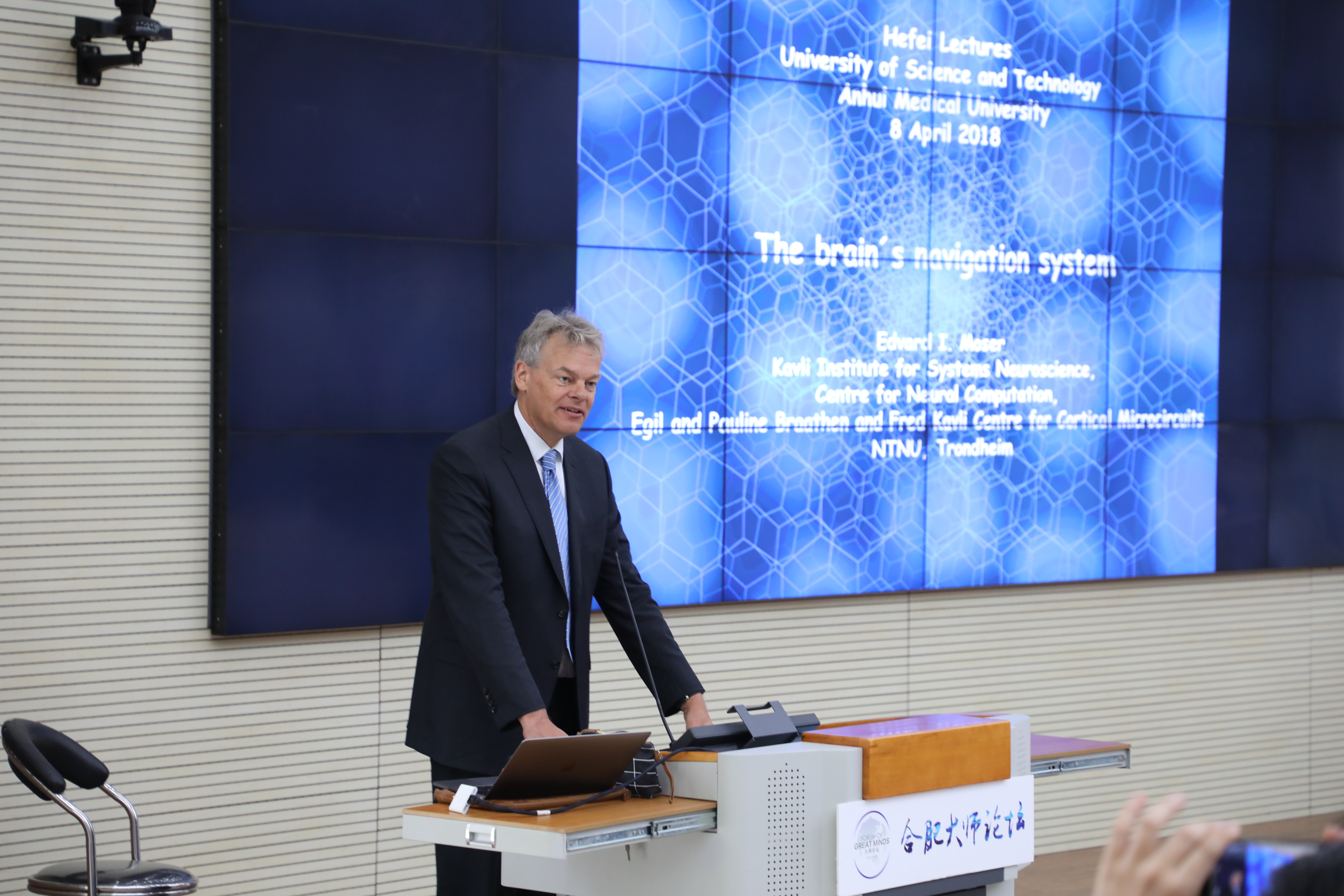Professor Edvard I. Moser, winner of the Nobel Prize in Physiology or Medicine, visited our school and was a guest at Hefei Masters Forum.
On the morning of April 8th, at the invitation of Anhui Foreign Experts Bureau and our school, Professor Edvard I. Moser, winner of the 2014 Nobel Prize in Physiology or Medicine, visited our school, accompanied by Pan Yaqun, member of the Party Group of Anhui Human Resources and Social Security Department and director of Anhui Foreign Experts Bureau. Vice President Chen Chusheng met with the guests. Xu Geliang, Dean of the First Affiliated Hospital of our school and Deputy Secretary of the Party Committee, and Professor Shen Yong from the College of Life Sciences attended the meeting.
Chen Chusheng first welcomed Professor Edvard I. Moser’s visit and introduced the general situation of the school. Subsequently, the two sides discussed the construction of the school’s life science and medicine department and related issues of brain research.

After the talks, Professor Edvard I. Moser gave a report entitled The brain′s navigation system in the multimedia classroom of the third teaching building in the West District. The report was presided over by Professor Shen Yong, and Director Pan Yaqun made a speech before the meeting.

Professor Edvard I. Moser vividly demonstrated the importance of the spatial positioning system of the brain to human life in ancient times through animation. Because the composition of the human brain is very complex, and mammals such as mice, rats and squirrel monkeys may have a common ancestor with humans in evolutionary history, and their brain structures are very similar, neuroscientists turned to the simpler mouse or rat brain for research. Then Professor Edvard I. Moser introduced the development history of the research on human brain location system, from the concept of cognitive map was put forward around 1930 to the discovery of location cells in hippocampus by Professor John O′Keefe around 1970. In 2005, Professor Edvard I. Moser’s team discovered another kind of grid cell for localization in the area of the entorhinal cortex near the hippocampus of the brain.

Professor Edvard I. Moser emphasized that the localization mechanism of hippocampus and olfactory cortex is completely different. The grid cells in the olfactory cortex can form a consistent and universal map when the environment changes, while the map composed of the position cells in the hippocampus has undergone earth-shaking changes with the environment changes. Therefore, the brain location system has two parts: the accurate location map of grid cells (low-dimensional) and the diversified map of location cells (high-dimensional). From the perspective of evolution, integrating the information of two sets of maps to navigate seems to be an efficient solution for animal navigation system. The distance and direction measured by the grid formed in the medial olfactory cortex will not change as it moves from one compartment to another. On the contrary, the location cells in the hippocampus form an independent map for each individual compartment, which makes it possible to store all kinds of memories. In the entorhinal cortex, in addition to the grid cells, Professor Edvard I. Moser and his colleagues also found the head direction cells, boundary cells and velocity cells, which all serve the system of mapping the world where mammals live. Through a series of experiments and data, Professor Edvard I. Moser showed that there are cells in the medial entorhinal cortex that can sense their own direction and distance from external markers, and discussed the mechanism of the lateral entorhinal cortex to perceive time, and suggested that there may be time cells besides grid cells and position cells.
Finally, Professor Edvard I. Moser pointed out that these studies are helpful for human beings to treat and understand Alzheimer’s disease, and the entorhinal cortex is one of the earliest brain regions in patients with Alzheimer’s disease. This disease causes degeneration of brain cells in the inner olfactory cortex, which eventually leads to cell death, which is consistent with the early symptoms of Alzheimer’s disease-disorientation of space and memory loss. With the increase of life expectancy, the incidence of Alzheimer’s disease is getting higher and higher. Professor Edvard I. Moser called for the joint efforts of related workers all over the world (from basic research to clinic) to cure and study the disease.

Professor Edvard I. Moser’s report gave us a deep understanding of the study of brain localization system. After the speech, the teachers and students present enthusiastically asked questions and exchanged ideas with Professor Edvard I. Moser.
During the visit, Professor Edvard I. Moser and his party visited the Neurodegenerative Disease Research Center and Brain Resource Bank (Brain Aging and Brain Diseases Research Center) of the School of Life Sciences of the University of Science and Technology of China with Professor Shen Yong, and offered their best wishes for the 60th anniversary of our school.
Edvard I. Moser, born in Norway in 1962, is now a Norwegian psychologist and neuroscientist, and the founding director of the Kafliko Institute of Systems Neuroscience and the Center for Memory Biology of the Norwegian University of Science and Technology. Mosor and his wife, Mai Britt Mosor, have led a series of cutting-edge research on brain mechanism in the past decades. In 2013, Edward Mosor won the Huo Weici Prize. In 2014, Edvard I. Moser, John O‘Keefe and May-Britt Moser won the Nobel Prize in Physiology or Medicine.
(Ministry of International Cooperation and Exchange)